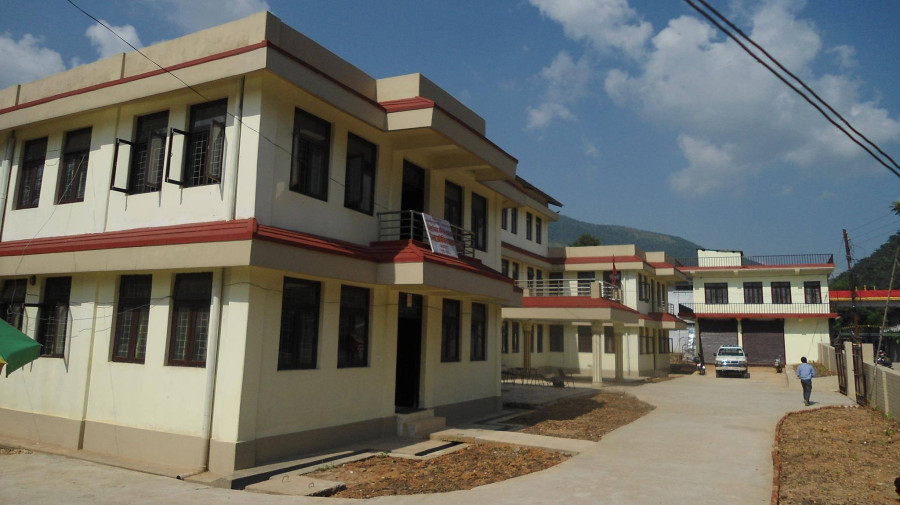National
Lack of resources and laws puts District Coordination Committees in confusion
Lack of laws and resources has rendered the District Coordination Committees—a mechanism envisioned by the constitution to monitor development and construction works of the local governments—ineffective.
Tika R Pradhan
Lack of laws and resources has rendered the District Coordination Committees—a mechanism envisioned by the constitution to monitor development and construction works of the local governments—ineffective.
The District Coordination Committees were formed as per Article 220 of the constitution to coordinate between the authorities of local level while monitoring development and construction works.
It has been almost two years since these committees were formed—with the mandate of five years—but they are still in confusion about their roles, as there is no clear work procedure.
“Due to the lack of proper work procedure and other necessary laws, we have become jobless,” said Sita Kumari Sundas, chairperson of the Association of District Coordination Committees of Nepal (ADCCN). “There are no resources—either financial or human resources—for us.”
The district committees were formed immediately after the local level elections in 2017.
Nepal held its first local elections in two decades in three phases on May 14, June 28 and September 18 in 2017 to elect representatives at six metropolitan cities, 11 sub-metropolitan cities, 276 municipalities and 460 rural municipalities.
A District Coordination Committee is elected by the District Assembly, which consists of the Heads and Deputy Heads of all the rural municipalities and Mayors and Deputy Mayors of all the municipalities in the district. The nine-member committee is elected by the District Assembly that includes a head, a deputy head, at least three women and at least one from the Dalit or minority community. Only members of the village assembly or municipal assembly in the district are eligible to contest in the election.
Leaving District Coordination Committees idle, according to DCC officials, has left the activities of the local levels unchecked, giving rise to chances of corruption besides affecting the coordination among local levels and with the provincial and federal governments.
The Commission for Investigation of Abuse of Authority recently pointed out that local units were one of the most corrupt institutions.
The anti-graft agency survey report titled “Study on Corruption and Good-Governance in Nepal-2075”, released on January 28, shows municipalities and rural municipalities are the second most corrupt entities after land revenue offices.
According to officials at the anti-graft agency, more than 20,000 complaints have been registered at the commission in the past nine months and that most of them were related to local level and the number is ever increasing.
“The authorities of local level think they are superiors and do not cooperate with District Coordination Committee officials for monitoring,” said Krishna Chandra Neupane, general secretary of the association.
“Some heads of the District Coordination Committees used to complain that the chiefs of local units used to threaten them saying who are they to monitor local governments,” added Neupane.
Even the system of informing the activities of the local level to committees has not been developed yet which officials said the work procedures and laws should define.
“There is no system of informing the committees about the planning of local level which is necessary to monitor their activities,” he added. Though the Local Government Operation Act 2017 has stated that the definition of local level also includes the District Coordination Committees but unlike the local level they have no executive power and the federal government has not allocated necessary budget to accomplish its activities.
The constitution says the District Coordination Committee should function according to the provincial laws, but none of the provincial assemblies has drafted any laws to manage the District Coordination Committees. “Provincial laws regarding District Coordination Committees are yet to be drafted,” said Lalbabu Pandit, Minister for Federal Affairs and General Administration.
The association had drafted a bill to manage the District Assembly and District Coordination Committee and forwarded it to the government authorities, but no action has been taken so far.
“The attitude of the authorities of local level is not positive towards us,” said Dan Bahadur Rawat, chief of the Humla District Coordination Committee. “They barely cooperate with us.”
The nine-member District Coordination Committee has so far visited a few project sites and roads, including Hilsa-Simikot road in the last two years, it has failed to monitor their financial dealings.
“We are in confusion. We don’t have procedure and resources,” said Rawat.
The Humla District Coordination Committee had one employee and an engineer but both of them will leave soon as they have been transferred as part of the civil servant adjustment plan.
The association has listed a number of issues to be raised to the federal government regarding their problems.
“The order of precedence should be managed and the benefits for the District Coordination Committee members must be uniform throughout the nation,” Sundas said. However, Minister Pandit said that the government has been working as per its priority areas and would gradually manage other things.
“A few human resources are with the District Coordination Committees now, but they are not sufficient. We will send more people soon,” said Pandit. “They should show their efficiency instead of complaining.”




 7.73°C Kathmandu
7.73°C Kathmandu









%20(1).jpg&w=300&height=200)





